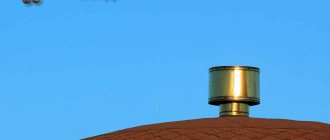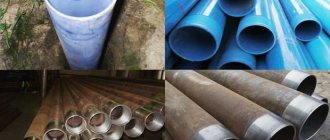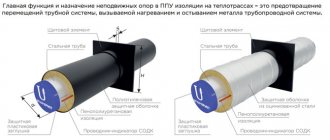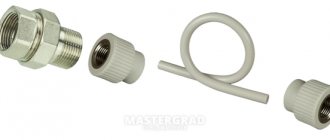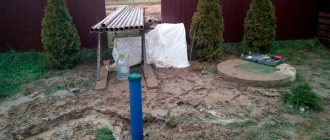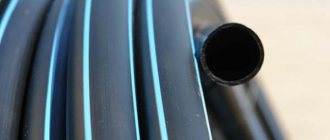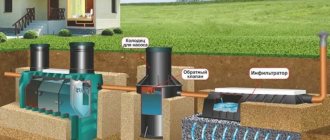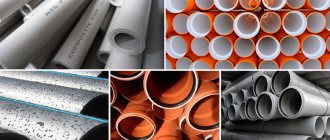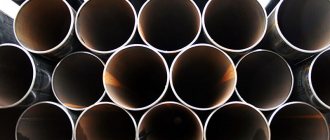Menu:
- Application of aluminum pipes - pipe AD 31
- Stainless steel pipe - use
- Models of metal-plastic pipes - the best option for heating
- Comfortable installation
- Video
Aluminum pipes have been actively used in the construction industry since the 80s of the last century.
They are produced in different shapes, they can be square, rectangular, round or a combination of different shapes, and different sizes, therefore they are a universal building material.
Due to the qualities of aluminum, environmental friendliness, resistance to chemical elements, and, as a result, non-toxicity, aluminum pipes are used in a wide variety of building structures, in machinery and shipbuilding, in aviation and many other industries.
Aluminum can withstand extreme temperature changes well, allowing it to be used in environments with extremely low or extremely high temperatures.
Properties and characteristics of aluminum pipes
The positive physical and chemical characteristics of non-ferrous rolled products made from pure aluminum or its alloys include the following: corrosion resistance, low weight, excellent weldability.
Aluminum products have low strength, but this disadvantage is compensated by the high ductility of the metal. It makes it possible to produce complex engineering structures.
In addition, aluminum does not change its physical and chemical properties when exposed to negative temperatures, which makes it indispensable in the manufacture of cooling climate control equipment.
The advantages of rolled aluminum products, which make it widely in demand in the metal market:
— long service life;
— wide operating temperature range from -80ºC to 120ºC;
— anti-corrosion qualities, immunity to aggressive environments;
— ability to deform without changing the basic properties at the point of deformation;
— environmental friendliness and hygiene of products;
— high coefficient of thermal conductivity (bimetallic radiators are made of metal).
Some of the above properties can be described in more detail.
1. Light weight. Allows you to significantly reduce the weight of the entire structure as a whole.
2. Good weldability properties. Aluminum pipes can be spot welded, using rollers or argon-arc welding. In this case, the corrosion characteristics of the seam do not differ from the general characteristics of the main product.
3. High anti-corrosion resistance. A natural oxide layer forms on the surface of the metal, which prevents corrosion. This oxide film is much stronger than the one that forms, for example, on the surface of iron. After mechanical stress, the oxide film is quickly restored. The same properties are preserved when the metal is in a stressed state.
Rolled aluminum pipes are sorted according to the method of technological processing and the thickness of the finished product.
Based on thickness, aluminum pipes are divided into thick-walled (thickness from 5 mm) and thin-walled (thickness up to 5 mm).
And according to the method of technological processing they distinguish:
— cold-hardened;
- semi-hardened;
— hardened;
- aged naturally and artificially.
Aluminum pipes have increased flexibility. Therefore, already at a temperature of about 20ºC, products can be easily deformed and the stability of the structure can be impaired. To eliminate this drawback and improve technological qualities, they are subjected to annealing and hardening (heat treatment) and cold hardening (mechanical processing).
Hardening (hardening) is a technological process of strengthening thermally untreated rolled aluminum at a temperature lower than the recrystallization temperature of aluminum. With the help of heat treatment and cold hardening, the physical properties of the metal change. From soft and plastic, it becomes hard and durable.
The technology described above makes it possible to produce structures and structures that can be used for a long time, since they are practically not exposed to the environment.
Some recommendations from professionals
When doing the work yourself, decide in advance about the need to use these products. Otherwise, there will be a significant financial overrun, since a cheaper material may be suitable to create a structure of the same strength.
To solder or weld aluminum profile pipes, the performer must have the appropriate skills. Therefore, carrying out such work can cause certain difficulties. If a large span is created, it is necessary to install additional stiffeners.
Despite the fairly high cost of profile aluminum pipes, these products occupy a large niche in the corresponding segment of the construction market.
Aluminum profile pipe
A profile aluminum pipe is a rectangle (PR), square (KV), of a certain size and thickness. Sometimes the section can be shaped (FS). Profiles are in demand for the manufacture of various structures, which are distinguished by strength and lightness. List of industries for application of profiled aluminum pipes - agriculture, industry, construction. Separately, we can highlight the architecture and design of the premises. Here, aluminum rolled metal is popular because of its attractive appearance, lightness, strength, and corrosion resistance.
Profile pipes, unlike round ones, have a number of advantages:
— by reducing metal consumption, the weight of the overall structure is reduced;
— profile rolled products are more convenient to store and transport;
— the structure is more rigid and can withstand heavy loads;
— often a rectangular or square pipe is needed for the construction of some elements.
Installation of profile pipes is carried out in two ways:
— using special fittings presented in a wide range;
- using welding.
An aluminum pipe can have a cross-section as follows:
- square (KV). In this case, the strength of the structure is determined by symmetrical stiffeners;
- rectangle (PR). It is used for uneven loads, when it is necessary to strengthen one side;
- shaped (FS). It is used in certain cases when there is a need to use a pipe of this particular cross-section.
Profile aluminum products are used for laying communications both inside and outside a building or structure. Such communications are durable, light, strong. The use of just such a profile affects the price of the finished product - it reduces the cost of the entire structure as a whole.
According to the production method, profile pipes are divided into:
1. Pressed. Manufacturing using a press.
2. Cold-formed. Here the workpiece is an aluminum circle, and manufacturing consists of successive operations of drawing, piercing and calibration.
3. Welded. Electric welding of aluminum sheets is used. The final product is a profile in the form of a square or rectangle. Then a hot tempering operation is performed. It is used to neutralize internal stresses in welds.
There are no joints or seams on the rolled surface. This makes the distribution of loads uniform across the edges of a rectangle or square. Therefore, even a small square pipe with a side of 2 centimeters can withstand significant loads. Among profiled products, the most commonly used aluminum tube is 40*40 (i.e., with a side of 40 mm). It is necessary for the installation of various structures in many industries.
Comfortable installation
An important point can also be said with confidence that the pipe models made from metal-plastic are convenient for installation and installation inside the home. They bend easily, which makes it possible to take the shape of any curves or wall openings, and their installation does not require the presence of special tools (except for manual crimping) and special skills.
Even an amateur who bought a pipe of the required length in a store has the opportunity to install the system according to his own plan. Metal-plastic pipes can be connected to pipes (or devices) made from any materials.
Aluminum pipe sizes
The following types are distinguished:
- thin-walled. Wall thickness up to 5 mm. This type of product is produced by most manufacturers of pipe products;
- thick-walled. Wall thickness from 5 mm.
GOST 18475-82, GOST 18482-79, GOST 23697-79 present the overall dimensions and theoretical (calculated) weight of 1 meter of pipe with a given wall thickness.
The range of cold-deformed aluminum pipes in accordance with GOST 18475-82 can be seen in the table, which shows the dimensions for finished rolled pipe profiles.
Outer diameter (D) - from 6 to 120 mm, wall thickness (S) - from 0.5 to 5 mm, weight of one meter - from 0.023 kg to 4.948 kg.
GOST 18475-82 also specifies the overall dimensions and weight of 1 meter of rolled pipes of rectangular and square cross-section, and round rolled products with an outer diameter of 130 to 150 mm.
The final product according to GOST 18475-82 can be of measured length or unmeasured. As a rule, for pipes of small diameter and thickness, the length varies from 1 to 6 m, and for larger diameters it should not exceed 4 m.
The range of extruded pipes made of aluminum and alloys in accordance with GOST 18482-79 can be seen in the table, which shows the dimensions of rolled pipes with a round section.
Outer diameter (D) - from 18 to 300 mm, wall (S) - from 1.5 to 40 mm, weight of one meter - from 0.222 to 93.116 kg.
The length of finished products in accordance with GOST 18482-79 can be unmeasured, measured, or a multiple of the measure, supplied in lengths. Usually it varies from 1 to 6 meters.
In addition, GOST 18482-79 contains sizing tables for pipes made from various aluminum alloys.
Main selection criteria
When choosing aluminum pipes for the construction of a particular facility, the following aspects should be taken into account:
- pipe manufacturing method;
- diameter, shape and other dimensions.
Pipe making methods
In modern production, the following methods for manufacturing aluminum pipes are used:
- cold deformation. A pipe with specified parameters is made from an aluminum circle by drawing and subsequent calibration. This method makes it possible to produce pipes with precise dimensions, including minimum diameters and high quality. The main disadvantage is the high cost;
Cold deformation pipe manufacturing technology
- pressing. Heated aluminum billets are passed through a special press with specified parameters. Pressed pipes are characterized by increased resistance to mechanical stress;
Production of pipes by pressing method
- welding An aluminum billet with specified dimensions is bent into the shape of a pipe. The ends of the workpiece are welded together. Pipes made by welding are most susceptible to cracking under high pressure or mechanical stress. Therefore, it is recommended to use them exclusively for domestic purposes and within reach for inspection and repair work.
Pipe production by welding
Selection of basic parameters
Aluminum pipes can be round, square, rectangular:
- round and oval pipes are mainly used in the construction of pipelines and ventilation systems;
- square and rectangular (profile) pipes are used for laying cables, constructing building frames, and constructing various structures.
Various shapes of aluminum pipes
Before constructing any structure, you should also take into account such parameters as:
- diameter of the pipe used. This parameter is of particular importance during the construction of sewerage systems, water supply, and so on, since the throughput of the system depends on the diameter;
- aluminum pipe wall thickness. The size of the maximum load depends on this parameter, which is of fundamental importance when laying pipelines underground or constructing various structures.
Main parameters of aluminum pipes
Each type of pipe is manufactured in accordance with GOST, which also regulates the standard dimensions of manufactured products. So:
- cold-deformed aluminum pipes must comply with GOST 18475 - 82;
- pressed pipes are manufactured according to GOST 18482 - 79;
- The welded pipe complies with GOST 23697 – 79.
Aluminum pipe production
According to the manufacturing method, rolled aluminum pipes are divided into three main types:
— aluminum pipes produced by pressing;
— manufactured according to the principle of stainless steel pipes, i.e. welding of a strip (tape) or sheet in combination with a hot tempering operation. It helps relieve internal stress on welding seams;
- made by cold deformation of a circle. The technology includes drawing, flashing and calibration.
In modern conditions, all types of production make it possible to obtain economical and high-quality products.
To produce a round aluminum pipe in accordance with GOST 22233-2001, non-ferrous metal marked A5, AD1, A8, AD, A85, alloys marked AMts, AMtsS, AMg1, AB, AD31, D1 are used.
The manufacturing technology includes several successive stages. First, the workpiece is heated, then pressed on the die of a rolling mill to obtain a circle shape. Then - pressing with a stamp in order to obtain an internal hole. Then a hardening operation is carried out. The last stage is carried out depending on the wishes of the customer. This is the application of an anodic coating to the surface of the finished product to thicken the natural protective layer.
Longitudinal welded pipes are made from tape. Aluminum alloys AMg2, VD1, AMg3, AMg5, D1, D16, AK6 are taken as the starting material.
The production technology is a continuous process of welding with high frequency current. The outer diameter, according to the assortment according to GOST 23697-79 (on straight-seam welded pipes made of aluminum alloys), varies from 10 mm to 220 mm.
Seamless cold-deformed pipes are made from metal alloys of the AMg2, D16, AMg3, AMg5, AMg6 grades.
Manufacturing method: drawing and calibrating rounded semi-finished products at low temperatures. The finished pipe product is used in many industries.
Based on the quality requirements for the final product, the surface must be smooth and even. The surface and sections must not contain defects such as:
- burrs, roughness;
— pockets of corrosion;
— traces of looseness, signs of burnout;
- cracks, cavities, chips, delaminations.
The following are not considered defects:
— dents that do not exceed the permissible deviations from the diameter;
— pressings, scratches that do not affect the minimum permissible diameter of the finished product;
- spots, stripes in the form of rings and spirals;
- residual material for lubrication.
Varieties
Depending on certain characteristics, aluminum pipes are divided into several types. Depending on their purpose and shape, products can be round or shaped. If the wall thickness is no more than 5 mm, then these pipes are considered thin-walled, and if the wall is thicker than 5 mm, they are considered thick-walled. Metal processing technology determines the following types of pipes:
- without heat treatment (no designation);
- annealed (marked with the letter “M”);
- hardened and naturally aged (designated as “T1”);
- hardened and artificially aged (o).
The manufacturing method affects the strength and other parameters of aluminum pipes, which may determine their scope of application.
Disadvantages of aluminum products
In addition to the advantages, aluminum pipes have some disadvantages:
Presence of carcinogenic properties. As a result of research, it was determined that aluminum, with prolonged exposure to the human body, can lead to the occurrence of malignant tumors. Therefore, recently they began to remove aluminum pipes from the construction of pipelines that are responsible for supplying water.
This problem can be solved using various impurities. Of course, as a result, this will reduce the performance properties of the products. Negative impact of low temperatures. When exposed to low temperatures, the surface of the pipes may become deformed.
Therefore, laying a pipeline in the ground must be approached very carefully. Utility lines must be located below the ground freezing level. If this is not possible, then experts recommend using an additional thermal insulation layer.
Of course, aluminum pipes have few disadvantages, especially when compared with the advantages. But you shouldn’t forget about them when choosing products. This especially applies to the scope of their application and the features of pipeline laying.
Product advantages
Aluminum pipes are widely used in various construction fields. Thus, a large number of pipelines used for oil production are made from these structures. This popularity lies in the fact that aluminum is highly resistant to aggressive substances.
Among the main advantages of aluminum pipes are: Not subject to corrosive processes. This advantage is only present in those pipes that are more than 95% aluminum. If we are talking about an alloy, then the situation here is somewhat different. Due to additives, products can rust, which significantly reduces their service life.
To further protect structures from the negative effects of moisture, they are coated with Vaseline. Light weight. Due to the low density of aluminum, products made from it weigh relatively little. This simplifies the loading, transportation and installation of aluminum pipes. So you can easily build a pipeline from such pipes with your own hands. Resistance to aggressive environments and chemicals.
Thanks to these advantages, pipes can last in the ground for several decades. During this time, the pipeline does not lose its strength and performance properties. High throughput. The inner walls of aluminum pipes have a smooth surface, which ensures high permeability of various substances. Aluminum pipes are the best option for constructing sewer and water supply systems. Water moves faster through such pipelines.
This also significantly reduces the risk of blockages and traffic jams.Easy to process. If necessary, aluminum pipes can be easily painted and finished, which allows you to disguise the pipes in the house, as well as further protect them from corrosion. The presence of such advantages explains the high popularity and widespread use of pipes in various industries. It is worth considering that such products must consist of 95% or more aluminum.
